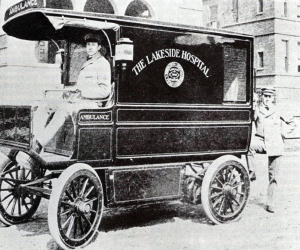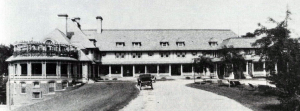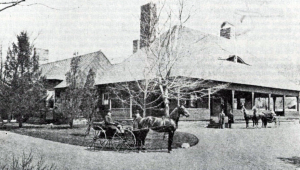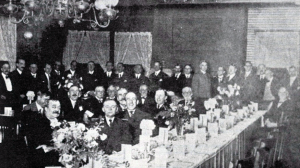Main Body
Millionaires’ Row: Membership

My father had one affiliation so dear to his heart he considered giving up his long banking career and much of his family time in devotion to it. Huron Road Hospital was his great life interest. Huron Road Hospital has been dedicated to providing quality patient care since 1874. It is the oldest teaching hospital in greater Cleveland. From its earliest days, it has always enjoyed an unusual social status. Mr. Mark A. Hanna was chairman of the board during the ’80’s. When he died, Colonel Myron T. Herrick became chairman of the board; when he was appointed Ambassador to France, my father, Dudley B. Wick, was appointed chairman of the board. Father served on the board for 38 years and most of that time headed the finance committee.
In volunteering to take on this responsibility with the hospital, Father went through some personal soul-searching. The Wick Bank, founded by my grandfather in 1847, had always been run by the Wick family, my father succeeding his father as president. Father was so interested in this work though that he wanted to retire from the bank to enable himself to devote the rest of his life to Huron Road Hospital. He realized my older brother, Dudley, was deeply interested in electrical engineering, not banking. And I was too young for the task.
Father made his big decision; he retired from the presidency of the Wick Bank in 1901, and devoted every day to Huron Road Hospital -arriving there right after breakfast, and either having lunch at the hospital, with my mother, or at the Union Club -then back to the hospital all afternoon. We were supposed to have our family dinner at 6:30 in the evening, but I can recall the many times F ather would call and sayan emergency had arisen -and we would postpone dinner until later. Father’s services were entirely volunteered, and he was very happy in doing all that he did.
In the early days, when hospitals were just getting started, homeopathy was in direct contrast to the accepted principle of allopathy. Huron Road Hospital early became affiliated with the Cleveland Homeopathic Hospital. It believed that diseases could be cured by small doses of medicine. I still remember the names of some of the homeopathic medicines, like “no x vomica”, “brionia”, and “acunite”, which were in our medicine cupboard. Fifteen drops to the half glass of water was the formula, and prescribed for two teaspoonfuls four times a day. I was also fascinated with Dr. Biggar’s powdered medicines. They were put up in pink and white folded papers, seeming to me more like a form of candy.
As time went on, both homeopathic and allopathic schools acquired more scientific sophistication, and began to grow more similar to each other as they incorporated new medical knowledge into their doctrines. The antipathy between homeopath and allopath continued well into the 20th century.
The Chief of Staff of the hospital was Dr. Hamilton F. Biggar, Sr., who was also our family physician and surgeon. We all loved Dr. Biggar. I remember, as a little fellow, how I used to like to sit on his lap. He was a large man, and when he laughed his entire body and stomach would shake. He reminded me of Santa Claus. But our family along with many other Cleveland families lost the services of this wonderful man when John D. Rockefeller prevailed upon him to become his personal physician; he then commuted among the various Rockefeller summer and winter estates.
While my father was busy with his many responsibilities at the hospital, my mother took on her own big job as president of the ladies’ auxiliary board. In those early days, hospitals were not organized with a regular purchasing department. My mother used to have Washington, her coachman, ready a team of horses to take her twice a week up to the Sheriff Street Market on East Fourth Street, where she picked out the vegetables for the hospital patients to enjoy. I remember when I was only five or six years old I used to enjoy going with Mother to the wholesale district. She would buy sugar by the barrel -wooden barrels in those days -flour by the barrel, and butter in large wooden tubs. To assure us the bottom of the butter was just as good as the top, the wholesaler would put a “tryer” down to the bottom of the wooden tub, then would let me try some from the depths, and ask me if that was all right for the hospital. I remember I would try a little portion of it . . . and assure him that it tasted very good to me.
Mother also had the responsibility of buying sheets, pillow cases, towels -all the linen ware and cottonware for the hospital. Charities and hospitals were very dependent on volunteer help to fullfill all their needs.
In the 1880’s and ’90’s, and for several years after the turn of the century, the social event each winter was the annual charity ball for Huron Road Hospital. In the early days it was given in the Gray’s Armory. I remember when they changed to the larger Central Armory, home of the Fifth Regiment. The place was completely festooned with white bunting and colorful decorations. The boxes lined the dance floor and sold for premium prices to the socially prominent, who were always well represented. The music at these balls was provided by two orchestras: one that played the waltzes, and the other at the opposite end of the Armory playing the twosteps, the popular dances of the time.
My father’s name was synonomous with the growth and development of that institution. When Father died, many people came to call on Mother expressing sympathy, and many told her how when some member of their family had been quite ill…Father would go to them with a receipted bill and say, “Don’t worry about paying the bill anymore; the main thing is to get well as soon as you can.” We never knew anything about it, for Father was quite modest about such things. But it made him very happy to do it.
When Huron Road Hospital moved out to Terrace Road in 1930 it continued to keep its famous name, which, by now, had gained a national reputation.
The development of Lakeside Hospital is an important element in Cleveland History.
In 1843 there was The Medical College of Western Reserve University, but there was no hospital and there were no patients. The Ladies’ Society of the Old Stone Church opened the Home for the Friendless. It was a rented dwelling on Lake Street near Erie (now Lakeside Avenue and East Ninth Street).
In 1875, The Cleveland City Hospital Society signed a 20-year lease with the U.S. government for Marine Hospital, built to provide care for sick seamen and soldiers. At a rate of 64¢ per day, no special form was used to record the prognosis of the sailors and soldiers; someone simply entered the words “died”, “discharged”, or “deserted”.
The most popular treatment for patients in 1870 was to “apply leaches on right leg, give acid and bark tonic, and apply tar water to scalp.”
In 1888, Cleveland decided to build its own City Hospital, and named it Lakeside. The most significant event in its history was joining Western Reserve University. This gave the Medical School the responsibility of supervising the Clinics as well as the use of the ampitheater, located at Erie and St. Clair Streets.
Lakeside consisted of eleven buildings connected by a basement. The 26 single rooms cost $12 to $50 per week; . ward patients paid a dollar a day.
The hospital was crowded with the poor. The patients fearful about operations had to be pressured by their families to undergo an operation. The wealthy, when sick, preferred to stay in their beautiful homes.
The eminent doctors on the staff insured an excellent hospital.
Dr. William T. Corlett started a new branch of medicine named dermatology. He made great advances in the treatment of syphillis. There was at one time a patient at Lakeside no doctor had been able to diagnose, but Dr. Corlett made the spectacular discovery that the patient was a leper. It was published in all the daily newspapers. I’m sure Lakeside did not greatly appreciate this publicity.
The major medical achievement at Lakeside was its development of gas anaesthesia; its dispensary was the first in the world to use it. The use of graduate nurses as anaesthetists was first tried at Lakeside under the direction of Dr. George W. Crile, a pioneer in the use of gas anaesthesia.
It is paradoxical that nurses were qualified to be anaesthetists, but were not allowed to administer penicillin shots when they were first introduced. The doctors made one exception -permitting the nurses to give the shots between midnight and six in the morning.
My wife Mildred relates some details about the special care then attendant upon the expectant mother:
“A great many of the trained nurses specialized in caring for the pregnant mother. It was the practice to have the nurse arrive at the residence two weeks before the baby was due.
“Miss Snow, a pretty young brunette nurse specializing in new baby care, was the favorite of the husbands and well liked by the women. The young society matrons later on went to MacDonald House to have their babies. The pampered women engaged an afternoon nurse besides their morning nurse, who had been staying at the house with them. They were smothered in luxury … with their own silk and lace blanket covers and a chauffeur bringing them hampers full of home-cooked delicacies.”
In January, 1931, Lakeside Hospital moved to its new location in University Circle on Adelbert Road. It retained the Lakeside name, although now far from Lake Erie. It joined the complex already formed by the medical school, Babies and Childrens and Maternity Hospital, the Institute of Pathology, and the Leonard C. Hanna House -all forming University Hospitals.
There were clubs to suit every activity or enthusiasm. I have already mentioned the summer colonies of cottages. Then, of course, there was the Country Club, and even the businessmen’s lunch club, the Chesire Cheese. We often spent time together as families in these varied settings, thus extending the geographic boundaries of Millionaires’ Row into all of these environments.
The tradition of the “gentlemen’s club” probably had its origins in England, and, like so many of the styles of the day, was copied on Millionaires’ Row. There were several unusual clubs that attracted the socially prominent. Membership in these clubs was carefully noted in code next to a man’s listing in the Blue Book, the Bible of high society.
One such prestigious club was, and is, the Tavern Club, founded in 1892, and originally occupying a house on the corner of Prospect and East Fortieth Street. When a new site was selected for a permanent facility, J. Milton Dyer won the competition as architect, to design the new club house to be built at Prospect Avenue and East Thirty-Sixth Street. He began drawing his plans in 1903. When the cornerstone was laid in 1904; members took money from their wallets, wrote their names on it, and tossed it -with other personal belongings -into the cornerstone copper box.
On January 1, 1904, the Club moved to its new building. When this ceremony took place, the members assembled at the old club and the entire membership marched in double file to East Thirty-Sixth Street. The parade was led by a push cart filled with glasses, ice and liquor, attended by waiters. Several outstanding features of the interior were leaded glass windows and the beautiful pictorial window in colors on the landing of the main stairway; the light fixtures were all specially designed.
The new club house was ideal for accommodating squash racquet courts on the top floor. The special material for the two courts was brought over from England, along with a crew of craftsmen to erect them, as no one in the United States was considered competent to do the special installation.
I found among my papers a copy of the Cleveland Town Topics, dated May 7, 1904; I have had it for 76 years. An article in this issue exclaims about the regal qualities of the new Tavern Club:
“The new Tavern Club opened in 1904 and is in many respects the handsomest club house in the country. The building is an adaptation of Elizabethian architecture. Mr. J. Milton Dyer, the architect, is a member of the club. The most attractive room “in the house is very large, with a great open fireplace. The walls are covered with imported French tapestry in a beautiful shade of red, and the ceiling is decorated to harmonize with the wall design. The hangings are changeable -red and green tapestry trimmed with gold bands; and heavy scrim sash curtains cover the windows. On the hardwood floor is a large, handmade rug with a green center and red border. Easy chairs and sofas are upholstered in brown Spanish leather especially designed for the room.
The members gave many rare and beautiful art pieces. A handsome lamp from Master William Edward Otis bears the inscription, ‘Hoping some day I’ll be a member just like Papa.’ Mr. James H. Hoyt gave a gold French mirror with candlelabra.
The balustrade of the main staircase, with Grueby tile in Chinese design set in the hardwood, is a very beautiful specimen.
In the dining room is another large fireplace. Mr. Fayette Brown gave a large copper kettle that stands by the fireplace.The tables are of solid dark oak and the chairs, of special design, are covered with red leather studded with nail heads; the Club’s monogram, in illuminated colors, ornament the backs.”
The membership was limited originally to 50 men, but is now increased.
The Tavern Club is still unique; there is no other club quite like it in the country. The membership has now grown to a limited 200; the admission requirement of unanimous approval makes us a happy, congenial group. I am happy to be a member and I frequently enjoy the fine luncheons and dinners there. The elegant building has been designated a Cleveland landmark, protecting it for the future.
An earlier exclusive gentlemen’s club is the Union Club, established in 1872. It was housed in a large brick building with five white columns. Set back on a deep lawn, it had formerly been the residence of Mr. Truman P. Handy. This is now the site of the Hippodrome Theater. About 1898, some members favored an extensive remodeling of the house. But, since business was moving east up the Avenue, some thought a new club house farther east was a better investment than spending a large sum on the old building. My father, with some other members, secured an option for the Club to buy the property on Euclid and the corner of East Twelfth Street. But, at the annual meeting, older members declared they would not travel “so far” out east just for lunch! The younger members prevailed, though, and Mr. Charles Schweinfurth was commissioned to design the new club house; now a favorite landmark.
One of the most interesting clubs in Cleveland is the Hermit Club. Founded by Frank B. Meade in 1904, he patterned it after the famous Lamb’s Club in New York City. He got a nucleus of amateur musicians and actors to help his ‘club’ move from the old Gattling Gun Battery. The first club house was on the west side of Hickox Alley, now East Third Street, running from Euclid to Prospect. In 1928 it moved to its present residence in Dodge Court. Meade and Hamilton were the architects.
The Hermit Club was famous for its amateur musical shows. One was staged at the old Euclid Avenue Opera House in 1905. It was called “The Hermits in Holland.” One feature with a political overtone was the chorus that danced and sang about our “three cent mayor.” (Tom L. Johnson was the advocate for establishing a 3¢ streetcar fare.
In 1909 they staged “The Hermits in Africa.” Their pony ballet stole the show. Hermit Club shows continued success· fully until the middle of the 20th century.
A month after my Yale graduation I was invited to join the University Club, and I became a member on July 15, 1909. The Club House was then located in the former Todd mansion, on Prospect Avenue west of Sterling Avenue (East Thirtieth). I enjoyed the two tennis courts, as well as dining in summer on the open porch while watching the game.
To cope with increasing membership the club decided to move, and sought to purchase the Sterling Beckwith property on Euclid at Case Avenue (East Fortieth).


It was an expensive undertaking, so the plan was to finance it by selling an issue of first Preferred Stock. Fortunately, the capable Finance Committee was composed of Warren S. Hayden, Chairman; Myron T. Herrick, Charles A. Otis, D. Z. Norton, Andrew Squire and William G. Mather.
Since they were all busy with heavy responsibilities, they appointed me secretary to do the leg work. My first assignment was to call on Mr. Charles F. Brush, the famous inventor, who had purchased the Beckwith property adjoining his elegant stone residence on Euclid Avenue. He had acquired the property to try to keep it from deteriorating and affecting his own property. (The finance committee did not tell me they had tried to sell Mr. Brush the stock, but had been turned down.) I urged him to buy our stock, convincing him that the neighboring property would fall into disrepair unless we sold enough stock to assure its future. The reasoning won him over, and when I reported his substantial purchase of stock it proved a happy conclusion to our dilemma.

And so the University Club made arrangements to move to the Beckwith mansion. As a dramatic gesture, we decided to all march over -from our old headquarters on Prospect to this new home on Euclid at Fortieth Street. I remember that my friend, Livingston Mather, decided we needed a marching song for the occasion -and he also said he had an idea for the song but nothing to write it on. I remember so clearly reaching into my pocket and handing him a large envelope; on the back of it “Liv” inscribed a wonderful song to the tune of the “Marseilles.”
“Come, brothers, lift your chorus high, and throw
your hearts into the song;
Yonder stands our swell club house -it’s vacuum
swept, as you will find.
It’s old in front, but new behindThe Club is old in front but new behind.
March on, march on, from the old club to the new . . .
But where in hell is the swimming pool?”
The housewarming dinner was on December 8, 1913. Purchasing the new club house, though, and building the new four-story dormitory building, had exhausted the club’s limited finances, preventing the buying of needed new furniture. So, the club had all the best stores in town send out on approval -tables, chairs, couches, lamps, rugs .. . all with the price tags left on. Then, at the dinner, it was announced that the club would be grateful to any members who would make a purchase.
At that point in the dinner, Elton Hoyt announced his table had raised $1800 to start the buying -provided Warren Wick would dance a clog on their table.
As soon as I finished my dance, Mr. Charles W. Bingham stood up and said Elton’s table offered peanuts: his table had a pot of $5000 provided I would dance on their table. After more table dancing the fun and excitement calmed down, and it was announced that all of the beautiful furnishings would be paid for and could remain at the club house.
The University Club maintained one strict rule for admission: a graduate degree from a recognized college was required. Tennis and squash racquets were popular. The club was always famous for its excellence in dining facilities.
I enjoyed being Chairman of the Entertainment and Admissions Committee, and a member for 34 happy years.
Mother and Father belonged to the Roadside Club and enjoyed going there for evening dinner, and luncheon on Saturdays. This beautiful club immediately adjoined the Glenville Racetrack and was the favorite eating spot for all the horseowning gentry and devotees of the ·races. The best chefs in the country were imported, making the Roadside Club the ultimate place for gourmet dining. There was a grand ballroom, as well as private dining rooms, answering the every need of its prominent membership.
In the summertime, after lunch, my parents would walk across the driveway to the Gentleman’s Driving Club of the Glenville Racetrack, sit in their box and watch the races. When I was in University School they would, as a great treat, occasionally take me with them to the races. They allowed me to ask a University schoolmate to go with me. Being young boys, we were not interested in the lacy dresses and colorful tulle hats worn by the ladies and religiously described in the Cleveland Town Topics:
“Mrs. Edmund K. Stalls was at the races with her sons Mark, Carl, and Dan Hanna, Jr. The boys are the sons of Senator Mark A. Hanna. She wore a white chiffon gown of flowered pink trimmed with lace and pale blue ribbons. Her hat was black ship with blue plumes.
Mrs. Wilson B. Chisholm, in another box, wore a gown of pale lavender batiste embroidered in white and a hat of white lace with pink roses.”
Some of the first tennis games were played on the lawn of the Billings residence, on Euclid Avenue at East Eighty-Eighth Street; later games were played on George Worthington’s lawn. Organized tennis began about 1880, with the forming of the East End Tennis Club; it eventually moved to its larger facility and club house at Forty-Sixth and Euclid. Later the Club moved to Carnegie and East Seventy-Seventh Street, and in 1923 it became the Cleveland Tennis and Racquet Club, moving to Shaker Heights on Fairhill and Kemper, with Henry C. Wick, JL as president.
Another prestigious affiliation was ‘Troop A’ Veterans’ Association, with its orignal headquarters at the Gattling Gun Battery Armory on Carnegie Avenue.
The troop ranked with the leading independent military organizations in the country. Later it was known as 1st Cleveland Cavalry; and, as Troop A, Ohio National Guard, it earned high honors for Cleveland in war and peace services. It served as honor guard for President Theodore Roosevelt, President Garfield, and President McKinley.
Troop A in World War I was stationed in Texas. One day the sergeant was conducting a drill and ordered his men to fall back six steps. One of the Troopers was disciplined for taking eight steps backward. He responded to his sergeant that Texas was big enough for him to take those two extra steps.
It was a busy way of life; it was an inbred way of life. Some small vestiges of it continue today. But, the almost daily excitement of meeting and mingling is really a part of the past.
